Do you know how to take care of cyclamen? Here we are telling you everything you need to know
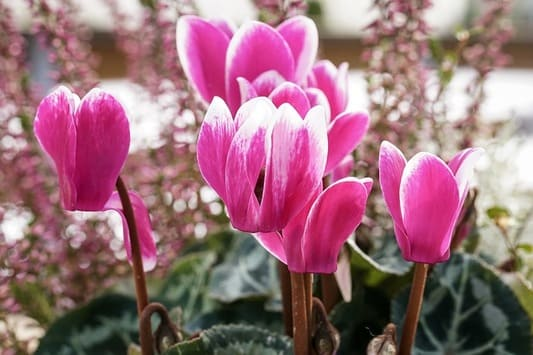
It is one of the most well-known flowers of the autumn.
When the cold arrives and the rest of the plants enter their period of lethargy, the cyclamen takes over and develops its flowers in a multitude of colours (from red to pink and fuchsia, passing through white).
But are you sure how to take care of it?
Do you know, for example, how to water it the right way to give it the water it needs without damaging the bulb?
Or what to do if you notice that your flowers wither prematurely?
And above all, do you know how to maintain it so that the same plant lasts from one year to the next?
If any of these questions have created doubts, then you shall keep reading.
Here we are going to explain in depth how to take care of your cyclamen so that it stays healthy and lasts for a long time.
Grab something to jot down, let's get started.
How to take care of a cyclamen: watering, temperature, sun exposure... (+2 extra tips)
Let's start by presenting the protagonist of this post properly:
The name "cyclamen" includes a wide variety of bulbous plants (more than 20 species in total) that grow in the forested areas of the eastern Mediterranean.
Said like this, you might think that this plant is well adapted to the mild temperatures typical of this geographical area.
And yes, it is… but in a slightly different way than other plants.
The cyclamen is a species that loves the cold. Thus, its flowering period occurs between autumn and winter, while in spring and summer the cyclamen goes into torpor.
This makes it an ideal plant to have in the garden in the autumn.
Having clarified this, we are going to see some cares that you should take into account.
1. Location: outside or inside?
Either one.
Coming from a climate very similar to ours, the cyclamen can live perfectly if we plant it in the garden (as long as we choose the site very well).
But on the other hand, this plant is not a special lover of the sun. That means it can also adapt to living indoors planted in a pot.
So it all depends on the space you have and your preferences.
Bonus tip: cyclamen is a toxic plant for animals and humans. Although ingesting it is not serious, it can cause diarrhea and vomiting (especially if the bulb is ingested). So if you have children or pets, it is preferable that you grow your cyclamen in a pot and out of their reach.

2. Temperature
As we said, cyclamen reacts in a somewhat special way to changes in temperature.
Its ideal range for flowering is between 5ºC and 15ºC. Above 16ºC, the plant will understand that its dormant season is coming and will discard its flowers.
If you grow it as a houseplant and you want to extend the flowering period, it is important that you keep it away from heat sources (such as radiators) and rooms that tend to stay warm.
For example, you can put it in the kitchen (where we don't usually put the heating on) or in a hallway.
Although there is also another trick.
So that the plant is exposed to the cold and its flowers last longer, you can take it outside for a few hours throughout the day.
Place it on the windowsill or on a balcony, where it is protected from heavy rain or even frosts, if you live in a very cold area.
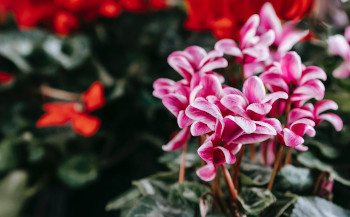
3. Exposure to light
Cyclamen does not get along with the sun.
If you plant it outdoors, be sure to place it in a place where it receives indirect light. Otherwise, direct sun exposure could burn your leaves.
Also, there is another problem.
During the autumn and winter, an excess of light could make the cyclamen think that summer has arrived, and that therefore it is time to throw its flowers and go into torpor.
If you grow it as a houseplant, just place it in a very bright room, ideally near a window.
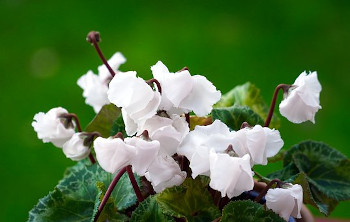
4. Watering
The cyclamen is a plant that needs a lot of water to live.
However, we must not forget that it is still a bulbous species; therefore, overwatering is one of your biggest enemies.
A waterlogged substrate will cause the bulb to rot and the plant will end up dying.
The ideal with this type of plants is to carry out immersion irrigation: you fill a container with water and immerse the pot in it so that the plant absorbs the water by capillarity through the roots.
After 5-10 minutes or so, remove the pot from the water and place it on a gravelly dish to allow excess water to drain.
In this way the plant will receive all the water it needs and you will not run the risk of the substrate becoming flooded.
Repeat the process every time you notice that the soil in the pot begins to dry out.
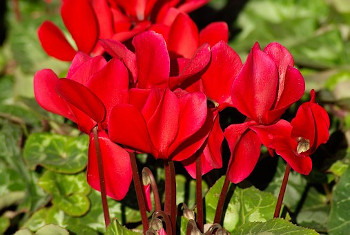
5. Substrate
We said that cyclamen needs its soil to keep moist but not overwatered.
And to achieve this delicate balance, having a well-draining substrate is essential. The usual is to use a mixture of peat and sand (and avoid clay soils).
For the rest, it is an undemanding plant regarding soil conditions.
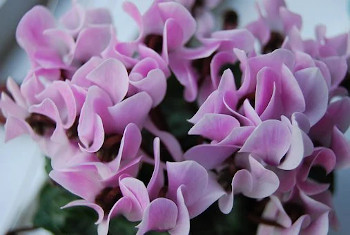
6. Fertilizer
If you want your cyclamen keep your flowers for long time, it is best to use a specific fertilizer for flowering plants.
This type of fertilizer is applied when the plant begins its flowering period (you will notice it by the appearance of bumps or "flower buds").
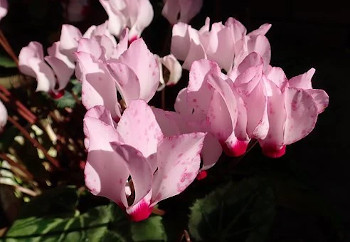
7. Pruning
Another important point to extend the flowering of the cyclamen is to remove the withered flowers.
These rob healthy flowers of nutrients, so it is advisable to remove them regularly.
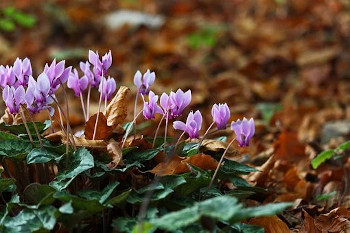
8. Reproduction of the cyclamen
There are two ways to achieve the reproduction of a cyclamen:
- By seeds: after the flowering period, the plant generates seed capsules that you can remove and store. Sowing takes place in late summer and takes about a month to germinate, but flowering will not occur until the following year. During the germination month, the substrate should always be humid and ideally at a temperature of between 18 °C and 22 °C.
- Bulb division: another option is to separate the bulblets, some protrusions that grow around the plant's bulb, and sow them as if they were seeds.
Both options are not interesting, but require continuous monitoring of the evolution of the plant during the first weeks.
Bonus tip 1: My cyclamen has withered leaves and / or flowers, is it serious?
It depends.
If you see that your plant has some flowers that begin to wilt, but others remain healthy, it is normal.
As we told you, throughout their flowering cycle some flowers die, and you simply have to prune them as we explained before.
A different matter is that this wilting affects all the flowers or even the leaves of the plant themselves.
There are several reasons why this can occur, but in the vast majority of cases the problem is overwatering. Check that the substrate drains well, that there are no flooded areas, and that the bulb is in good condition.
If this happens, let the substrate dry for a few days before watering again.
Bonus tip 2: How can I keep my cyclamen from one year to the next?
Another very common question is this.
All varieties of cyclamen are perennial plants, which means that they keep their leaves even during the dormant period.
For that you simply have to take into account the advice we have given you:
- Water the plant frequently, better with immersion.
- Keep it in a cool place (very important during the summer) and where it receives indirect light.
- Prune any wilting branches so they don't rob the plant of energy.
With these cares you will see that your cyclamen blooms again when winter arrives.
Another option is to remove the bulb from the ground and keep it until the following autumn.
What you have to do in this case is to clean it very well, prune it and store it in a dry and dark place (preferably inside a bag to avoid being affected by humidity). Then in autumn, you sow it normally again.
Now you know how to take care of your cyclamen so that it lasts a long time.
Cyclamen has a reputation for being difficult.
But as you can see, taking into account some simple care it is a very easy plant to grow and, above all, very grateful.
Anyway, remember that if you have any questions, you can contact us.
We will gladly help you take care of your plants.

 English
English Spanish
Spanish